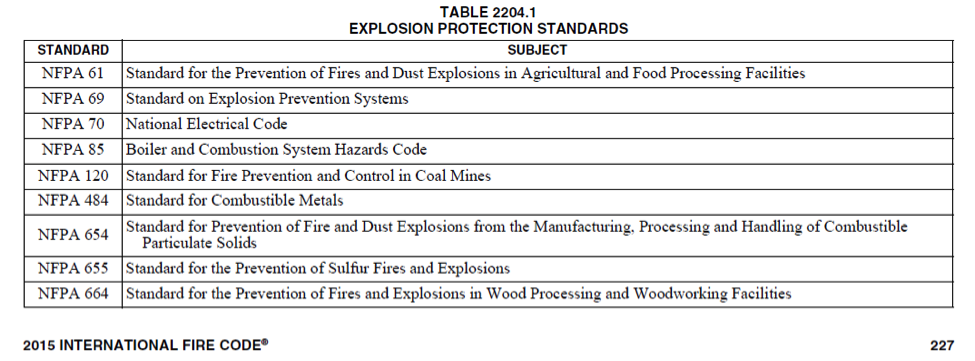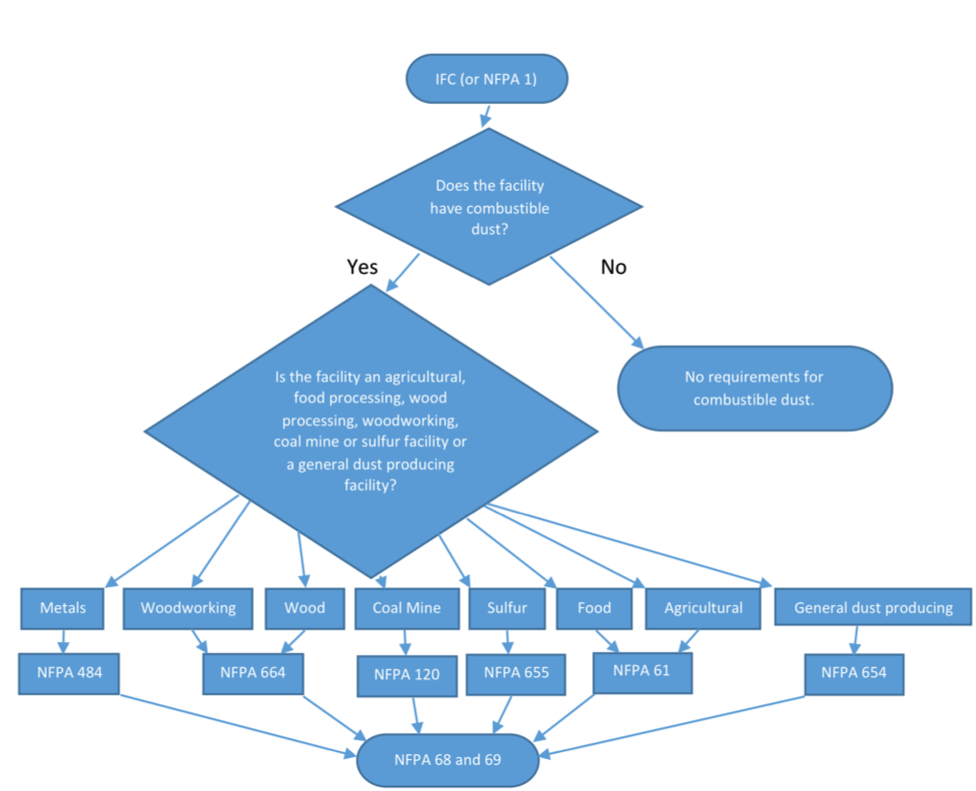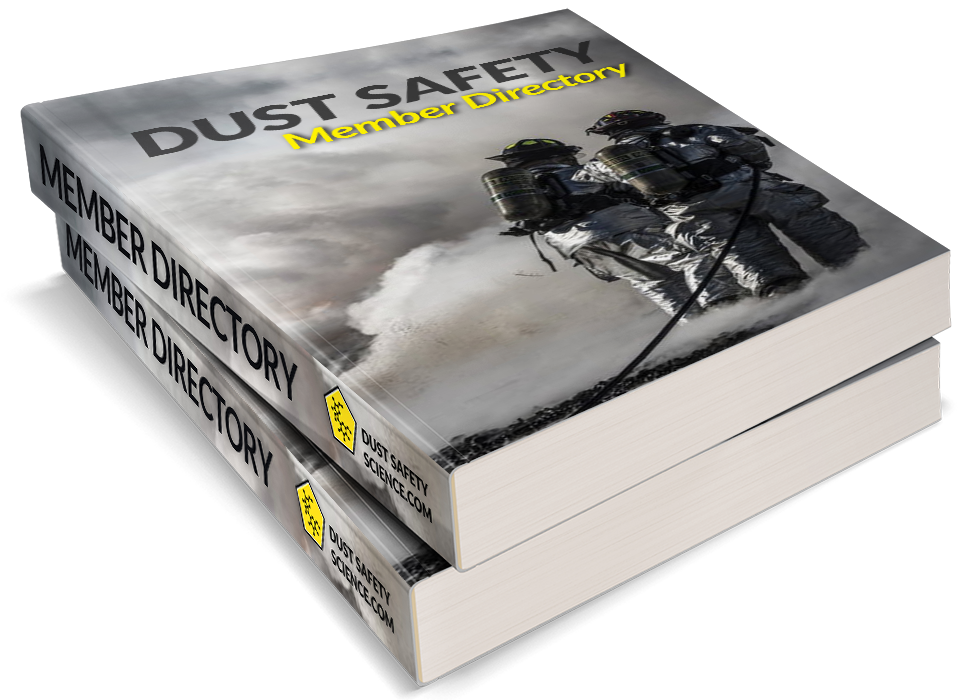Guest Author: Russell Bainbridge
It is often difficult to convince facility owners why adhering to combustible dust standards is required. From my experience one of the best places to start is by demonstrating that these standards are law. This process begs the question:
How do standards become law in the first place?
The current article aims to explain the adoption process and how the International Fire Codes, International Building Codes, and NFPA Standards are linked.
If you have any questions or would like to share how combustible dust standards are included in your jurisdiction, leave them in the comments box at the bottom of the post or reach out directly to connect.
Code Verses Standard
NFPA standards become law when they are included and referenced in an adopted code and/or are adopted on their own by a jurisdiction. “A code is a model, a set of rules that knowledgeable people recommend for others to follow. It is not a law, but can be adopted into law” [1] per NFPA. On a different page on NFPA’s web site they also state a code is “a standard that is an extensive compilation of provisions covering broad subject matter or that is suitable for adoption into law independently of other codes and standards” [2].
“A standard tends be a more detailed elaboration, the nuts and bolts of meeting a code” [1] per NFPA. And, more specifically “An NFPA Standard, the main text of which contains only mandatory provisions using the word “shall” to indicate requirements, and that is in a form generally suitable for mandatory reference by another standard or code for adoption into law. Nonmandatory provisions are not to be considered a part of the requirements of a standard and shall be located in an appendix, annex, footnote, informational note, or other means as permitted in the NFPA Manuals of Style.
When used in a generic sense, such as in the phrases “standards development process” or “standards development activities”, the term “standards” includes all NFPA Standards, including Codes, Standards, Recommended Practices, and Guides. The term NFPA Standard also includes, as the context requires, proposed NFPA Standards that are in the process of development or revision” [2]. Once it is confirmed which codes and/or standards are adopted by a jurisdiction then the engineers, architects, facility operators and facility owners are required by law to adhere to those codes and/or standards.
Fire and Building Code requirements
There is a lot of confusion about what is required by fire and building codes for protection against combustible dust. Table 5003.1.1(1) Maximum Allowable Quantity per Control Area of Hazardous Materials Posing a Physical Hazard from the 2015 International Fire Code (IFC) [3] classifies any area with combustible dust as an H-2 occupancy (High-hazard occupancy that poses a deflagration hazard) and, because of this, the requirements in Chapter 22, Combustible Dust-Producing Operations, of the IFC are applicable and a combustible dust-producing operations permit is required per § 105.6.7 and § 2201.2 of the IFC, if the IFC is adopted by the local jurisdiction.
The International Fire Code dedicates only one page to Chapter 22, Combustible Dust-Producing Operations. This page directs engineers, architects and authorities having jurisdiction to the applicable NFPA standards. The standards listed in Chapter 22 Table 2204.1 Explosion Protection Standards are considered part of the IFC, thus are enforced as law as stated in § 102.7 of the IFC.

It should be noted that NFPA 652, Standard on the Fundamentals of Combustible Dust and NFPA 68, Standard on Explosion Protection by Deflagration Venting are not included in Table 2204.1. Since NFPA 652 is not included, it is not required by law or § 102.7 but it could be required by the local jurisdiction and it should still be adhered to as a best practice. NFPA 68 is referenced in the NFPA standards in Table 2204.1 and because of this NFPA 68 is considered part of the code even though it is not directly listed in Table 2204.1.

Since combustible dust areas are considered H-2 occupancies, there are other International Building Code (IBC) [4] requirements as well. For example, Table 508.4 Required Separation of Occupancies (Hours) of the IBC has requirements for fire resistant construction separation for H-2 occupancies from other occupancies. All of the requirements for H-2 occupancies in the IBC also have to be adhered to for combustible dust areas.
Of the nine standards listed in Table 2204.1, five of those are standards for specific occupancies:
-
- NFPA 484, Standard for Combustible Metals
Any occupancy that has combustible dust but doesn’t qualify under one of the specific occupancy standards will have to meet the requirements in NFPA 654, Standard for Prevention of Fire and Dust Explosions from the Manufacturing, Processing and Handling of Combustible Particulate Solids.
The final standard listed in Table 2204.1 is the design standard NFPA 69, Standard on Explosion Prevention Systems, which covers how to meet requirements within the specific occupancy standards and NFPA 654. There are two more items from NFPA (NFPA 70, National Electrical Code and NFPA 85, Boiler and Combustion System Hazards Code) in Table 2204.1 and it has them listed as standards but NFPA has written and formatted them to be adopted by jurisdictions as codes. Again, all of these standards listed are effectively code because they are listed in Table 2204.1 and are to be enforced as such.
If a jurisdiction adopts NFPA 1, Fire Code [5] instead of the International Code Council codes (IFC and IBC) there are similar requirements. As in the IFC, NFPA 1 also classifies combustible dust areas as Industrial, High Hazard occupancy, due to combustible dust being considered High Hazard Level 2 Contents. Chapter 40, Dust Explosion and Fire Prevention covers the requirements for combustible dust in NFPA 1. Just as in the IFC, NFPA 1 list the required NFPA standards to adhere to for combustible dust in § 40.1. Again, it must be noted that NFPA 652 is not included. The major difference between NFPA 1 and IFC is NFPA 1 brings directly in a lot of requirements from NFPA 654, Standard for the Prevention of Fire and Dust Explosions from the Manufacturing, Processing, and Handling of Combustible Particulate Solids.
Future of Combustible Dust Standards
NFPA 652 is the new NFPA standard to try to develop more consistency within the NFPA combustible dust framework. NFPA 652 was released as part of the 2016 standard cycle, thus not able to be included in the 2015 ICC code cycle. The International Code Council committees are reviewing NFPA 652 to determine if it will be referenced and included in the next edition of the IFC and IBC (2018).
If included in the next code cycle for ICC codes, it will be the overreaching standard for combustible dust and the standard where engineers, architects and authorities having jurisdiction will start when reviewing combustible dust requirements. After NFPA 652 is reviewed by engineers, architects and authorities having jurisdiction then the specific occupancies standards or NFPA 654 will be reviewed. NFPA 652 will be included in the next edition (2018) of NFPA 1.
References
[1] “About codes and standards,” NFPA, 2016. [Online]. [Accessed 18 July 2017]. [2] “Terminology,” NFPA, 2016. [Online]. [Accessed 18 July 2017]. [3] 2015 International Fire Code, Country Club Hills, IL: International Code Council, 2014. [4] 2015 International Building Code, Country Club Hills, IL: International Code Council, 2014. [5] NFPA 1 Fire Code 2015 Edition, Quincy, MA: NFPA, 2014.

Mr. Bainbridge is a Fire Protection Engineer at Barry-Wehmiller Design Group in Fort Worth, Texas, and holds a Masters in Fire Protection Engineering from California Polytechnic State University. Russell has extensive background in fire hazard assessment and working with individual companies and Authorities Having Jurisdiction on code and standard reviews.
